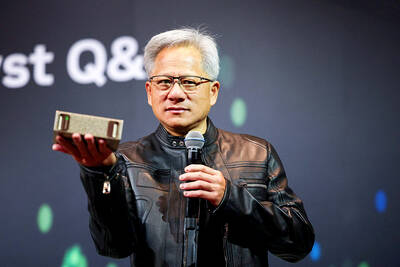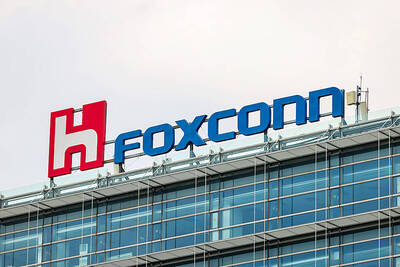Apple Inc might make one out of four iPhones in India by 2025, JPMorgan & Chase Co analysts said yesterday, as the tech giant moves some production away from China, amid mounting geopolitical tensions and strict COVID-19 lockdowns in the country.
JPMorgan expects Apple to move about 5 percent of iPhone 14 production from late this year to India, which is the second-biggest smartphone market in the world after China.
It is also estimating that about 25 percent of all Apple products, including Mac, iPad, Apple Watch and AirPods, would be manufactured outside China by 2025 from 5 percent currently.

Photo: Reuters
The US company has bet big on India since it began iPhone assembly in the country in 2017 via Wistron Corp (緯創), and later with Pegatron Corp (和碩) and Hon Hai Precision Industry Co (鴻海精密), also known as Foxconn Technology Group (富士康科技集團) internationally, in line with the Indian government’s push for local manufacturing.
The COVID-19 pandemic hampered supply chain relocation plans for businesses, but with restrictions easing, more companies, including Apple, are reaccelerating these efforts this year.
“Taiwanese vendors such as Hon Hai and Pegatron play a key role in the relocation to India. In the medium to long term, we also expect Apple to qualify local India manufacturing suppliers,” said JPMorgan analysts led by Gokul Hariharan, who is rated 4 out of 5 for estimates accuracy.
A Bloomberg report earlier this month said that Indian conglomerate Tata Group was in talks with Wistron to establish a joint venture to assemble iPhones in the country amid Apple’s plans to cut production lag with China.
In other news, the Indian government yesterday raised fiscal support for new semiconductor facilities to cover 50 percent of project costs and said it would remove a ceiling for maximum permitted investment for display manufacturing as it moves to boost local production.
The announcement comes as Indian Prime Minister Narendra Modi’s government seeks to attract more big-ticket investments under a US$10 billion incentive plan for chip and display production, aiming to make India a key player in the global supply chain.
“On the basis of discussion with potential investors, it is expected that work on setting up the first semiconductor facility will commence soon,” a government statement said.
The government had previously agreed to cover between 30 and 50 percent of the cost of setting up new display and chip plants.
The government yesterday said it would also cover 50 percent of the capital expenditure required to set up semiconductor packaging facilities.
Last week, oil-to-metals conglomerate Vedanta Ltd and Hon Hai signed a pact with India’s Gujarat to invest US$19.5 billion in the western state to set up semiconductor and display production plants.

SEEKING CLARITY: Washington should not adopt measures that create uncertainties for ‘existing semiconductor investments,’ TSMC said referring to its US$165 billion in the US Taiwan Semiconductor Manufacturing Co (TSMC, 台積電) told the US that any future tariffs on Taiwanese semiconductors could reduce demand for chips and derail its pledge to increase its investment in Arizona. “New import restrictions could jeopardize current US leadership in the competitive technology industry and create uncertainties for many committed semiconductor capital projects in the US, including TSMC Arizona’s significant investment plan in Phoenix,” the chipmaker wrote in a letter to the US Department of Commerce. TSMC issued the warning in response to a solicitation for comments by the department on a possible tariff on semiconductor imports by US President Donald Trump’s

‘FAILED EXPORT CONTROLS’: Jensen Huang said that Washington should maximize the speed of AI diffusion, because not doing so would give competitors an advantage Nvidia Corp cofounder and chief executive officer Jensen Huang (黃仁勳) yesterday criticized the US government’s restrictions on exports of artificial intelligence (AI) chips to China, saying that the policy was a failure and would only spur China to accelerate AI development. The export controls gave China the spirit, motivation and government support to accelerate AI development, Huang told reporters at the Computex trade show in Taipei. The competition in China is already intense, given its strong software capabilities, extensive technology ecosystems and work efficiency, he said. “All in all, the export controls were a failure. The facts would suggest it,” he said. “The US

The government has launched a three-pronged strategy to attract local and international talent, aiming to position Taiwan as a new global hub following Nvidia Corp’s announcement that it has chosen Taipei as the site of its Taiwan headquarters. Nvidia cofounder and CEO Jensen Huang (黃仁勳) on Monday last week announced during his keynote speech at the Computex trade show in Taipei that the Nvidia Constellation, the company’s planned Taiwan headquarters, would be located in the Beitou-Shilin Technology Park (北投士林科技園區) in Taipei. Huang’s decision to establish a base in Taiwan is “primarily due to Taiwan’s talent pool and its strength in the semiconductor

French President Emmanuel Macron has expressed gratitude to Hon Hai Precision Industry Co (鴻海精密) for its plan to invest approximately 250 million euros (US$278 million) in a joint venture in France focused on the semiconductor and space industries. On his official X account on Tuesday, Macron thanked Hon Hai, also known globally as Foxconn Technology Group (富士康科技集團), for its investment projects announced at Choose France, a flagship economic summit held on Monday to attract foreign investment. In the post, Macron included a GIF displaying the national flag of the Republic of China (Taiwan), as he did for other foreign investors, including China-based